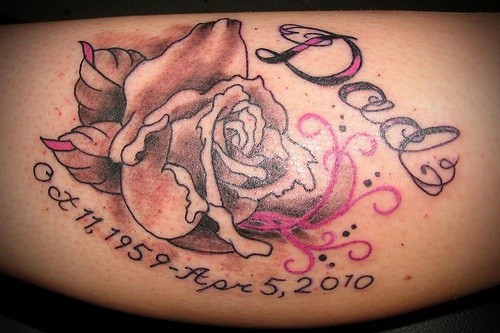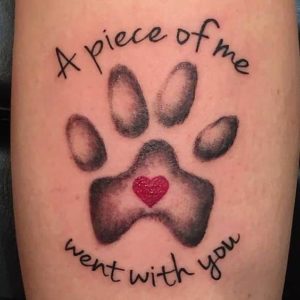
Credit: tattoo.me
Cremation is rapidly becoming the most popular form of final disposition in many developed countries. According to the latest data from the Cremation Society of North America, the cremation rate in the United States in 2016 exceeded 50 percent for the first time in history. And it was just over 70 percent for our neighbors to the north. If this trend continues at the rate experts predict it will, the percentage of people choosing cremation over other forms of disposition will reach 56 percent in the United States and 80 percent in Canada within the next two years.
Not surprisingly, the increase in the number of people who choose to be cremated has spurred new traditions and rituals around saving the ashes of the dead. One example: rather than scattering their loved ones’ ashes or saving them in an urn, many people now place tiny bits of the ashes in specially made jewelry that they wear all the time. Others take the idea of keeping their loved one with them at all times to an entirely new level by having their ashes mixed with tattoo ink to create cremation tattoos.
What Are Cremation Tattoos?
Cremation tattoos are, first and foremost, a personal expression of love and remembrance of someone who has died. Like other memorial tattoos, they often consist of a picture, a saying, or even a portrait of a person who has died. The difference between a cremation tattoo and a memorial tattoo is that the tattoo artist mixes a tiny bit of the loved one’s ashes in the tattoo ink for a cremation tattoo. Thus, the ashes are actually a part of the tattoo and a permanent part of the person wearing it.
 Not all tattoo artists are familiar with the technique for making cremation ink, which requires an extra bit of care. Although the practice is probably safe, Health Canada has warned against it, stating in an email to the National Post, “Due to the composition of the ashes being unknown and the potential for adverse reactions, Health Canada does not recommend this type of tattooing practice.” Thus, it’s important for anyone considering the idea to find an experienced artist who knows how to mitigate the risks. For example, the ashes must be filtered before mixing them with the ink to ensure that only a fine dust remains. Additionally, they should be sterilized prior to use to minimize infection risk. (Ashes are sterile, but may be contaminated during handling.)
Not all tattoo artists are familiar with the technique for making cremation ink, which requires an extra bit of care. Although the practice is probably safe, Health Canada has warned against it, stating in an email to the National Post, “Due to the composition of the ashes being unknown and the potential for adverse reactions, Health Canada does not recommend this type of tattooing practice.” Thus, it’s important for anyone considering the idea to find an experienced artist who knows how to mitigate the risks. For example, the ashes must be filtered before mixing them with the ink to ensure that only a fine dust remains. Additionally, they should be sterilized prior to use to minimize infection risk. (Ashes are sterile, but may be contaminated during handling.)
Why a Cremation Tattoo?
The idea of a tattoo doesn’t appeal to everyone, but the practice has become more mainstream in recent years. According to the number crunchers from Statistic Brain, about 45 million Americans have at least one tattoo, and the percentage of young people sporting a tattoo is now between 36 and 40 percent. Once a symbol of rebellion, tattoos are now an acceptable way to express one’s personality, values, emotions and beliefs. As such, more and more people are finding that a tattoo memorializing someone they love helps them process and move through their grief.

Credit: tattooideasformen.net
“My dog was never away from me while he was alive,” a friend recently said. “He was my constant companion. He slept in my bed, rode ‘shotgun’ in my car, and came with me to work every day. When he died, I wanted to keep him close to me forever. So I had his ashes tattooed here,” she said, pointing to the paw-print tattoo on her left wrist.
Traditions evolve, as the shift to cremation over burial proves. And as our traditions around caring for our dead change, so, naturally will our openness to new ways of remembering them. And, at least according to York University sociologist Deborah Davidson, who is researching the trend towards more public grieving in countries such as Canada and the U.S., that’s definitely a good thing. “Death is sanitized in our culture,” she says. “We take it out of the closet for the funeral, and that’s it…But tattoos reopen that dialogue.”
Certainly, cremation tattoos are not for everyone. But if they serve the purpose of bringing death and loss and grief into the open, I couldn’t agree more.

 Cremation Tattoos: A Modern Approach to Honoring Our Dead
Cremation Tattoos: A Modern Approach to Honoring Our Dead


 How Dare You Die Now!
How Dare You Die Now!
 Debating Medical Aid in Dying
Debating Medical Aid in Dying
 “Help Me, Helen”
“Help Me, Helen”














